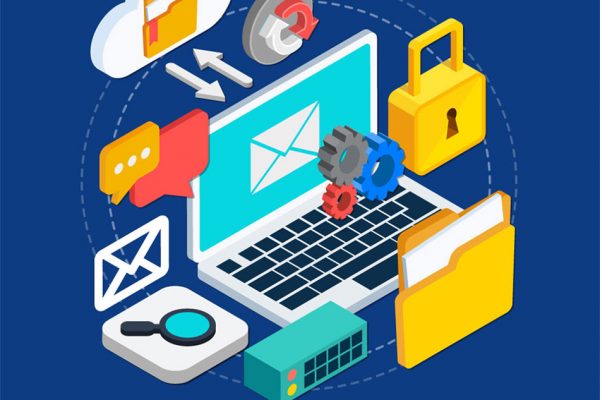Cloud & Security
SmartRoby is hosted on two benchmark Cloud platforms: AWS and OVH. The choice of hosting depends on your strategic priorities and your technological preferences/constrains. Thus, SmartRoby is available in the AWS Marketplace as a ready-to-use service in the form of EC2 instances. You can access our process governance platform in a few clicks and use our process assessment module for free. You can instantiate a private version of SmartRoby dedicated for you.
At the same time, we also offer hosting on OVH in the form of a private cloud managed completely by Novelis. This enables us to ensure the best conditions of execution and interfacing in complete safety with your IS. For each Robot, VPN access is set up between SmartRoby and your Information System (IS), thus providing secure access to the applications necessary for the execution of your automated processes.
Robots are considered working-from-home agents who access your IS. The same rules and security guidelines will therefore apply with end-to-end encryption, strong authentication and a deployed audit system to control and allocate, in an irrevocable manner, all the actions carried out by these agents.

SmartRoby as a SaaS solution
Choosing to use SmartRoby as Software as a Service (SaaS) solution, means choosing to save time and cost in terms of setting up and maintaining the infrastructure for running robots.
- Reduced and controlled Costs
- A smaller “Automation To Production” gab
- Guaranteed Performance
- Scalability on demand
- An agnostic solution to automation technologies
The portal access is managed through Identity & Access Management (IAM), implementing standard authentication and identity federation protocols: OAuth2, OpenIDConnect and SAML2.
Access Modes to IS applications
Access to your information system applications is made using dedicated accounts. Each Robot has a unique account identifying it in your IS. The connection between the server, hosting the robot, and your information system is ensured by strong authentication, and all access is audited in an irrevocable manner.
The transmitted data between the instances of Smart Roby robots and your Information system passes through a secured VPN tunnel. Thus, all the manipulated data during the execution of the processes is end-to-end encrypted. The APIs (Application Programming Interface) exposed by SmartRoby are also secured by an SSL certificate protecting the communication against any interception or any man-in-the-middle attacks.
If you already have applications hosted on AWS, a site-to-site connection is possible for interconnecting the VPC of the robot’s EC2 instances and that of your Information System hosted on AWS. This allows for robust communication while ensuring high level of security.
All SmartRoby’s hosting is ISO 27001 certified. Security was at the heart of the design of the platform, and compliance with the strictest requirements of the ISO 27001 standard guided the development of the solution. All access to the platform and to the servers are insured by MFA authentication. All the transactions are audited and are subject to regular review by our ISSO.
Architecture and Scalability
The SmartRoby platform is built on a microservices architecture driven by a Kubernetes orchestrator. These microservices communicate with dedicated robot instances. Partitioning application and network between these different robots is put in place to ensure a strong seal between them. Thus, your execution data is isolated in a database dedicated for you. “At Rest” and “In Transit” encryption of this data helps ensure maximum confidentiality. On the other hand, network segmentation insures a level of partitioning identical to that of a dedicated hosting. The only communication channel between the portal and the robot passes through a secure asynchronous bus allowing execution data to be aggregated to the portal. Also, this bus enables transporting the basic orders of execution management, such as an upcoming launch and a scheduled execution.
Neither personal nor business data is stored on the platform. Only the execution data, such as: Start date, End date, duration of processing, number of handled cases… etc, are saved by default. The deployed auditing and encryption technologies also make it possible to respond to cases where the backup of certain business data is needed for reasons of restoration and reporting in the portal. This data is encrypted throughout the processing chain: in the database (At Rest) and in the restitution phase (In Transit). MFA authentication achieves maximum protection against account theft and password leakage.

Microservices Architecture
We have chosen to construct our solution on a distributed architecture based on microservices. This enabled us to equip the platform with a certain agility and a strong ability to adapt to different IS contexts.
- Modular Architecture
- Openness to RPA Technologies
- Real-time Exchange
- Reinforced Security
- Automated Scalability
- High Performance
Robots on Demand
The architecture of SmartRoby is also a guaranteed Scale-out capacity. Reinforcement robots can be instantiated dynamically to support load peaks. These robots are available at hourly rate and enables you to build up the capacity needed to run your automated processes under the desired performance conditions.
Scalability can be configured in a programmed manner: for seasonal peaks in loads, or associated with observed events: large number of business cases, for example.
API Access
The SmartRoby portal simply responds to the needs of the Business users. It provides a consolidated, comprehensive and simplified view of the efficiency of the automated processes. It also enables decision-makers to follow the ROI in real time.
However, you may need to manage SmartRoby through your portals and applications already in place. Integrate execution metrics into your monitoring tools, display certain consolidated data on your Grafana dashboards or associate certain events with personalized notifications in your business portal. All of this is made possible by APIs.
OpenAPI V3 documentation accessible via a Swagger interface allows your teams to understand the different APIs of the platform in self-service mode. All these APIs are exposed in RESTfull style. Authentication is handled by the OpenID Connect protocol coupled with SSL certificate authentication.
SmartRoby’s APIs enable the full potential of Robots to be exploited. They make it possible to manage the execution of processes, the retrying of exceptions, the retrieval of business metrics and indicators, the scheduling of executions as well as everything that SmartRoby offers through its screens. So all the power of the platform is in your hands to exploit in your own tools and applications.

Using the APIs
To use the APIs, you must generate an SSL certificate for client authentication. Then, a dedicated account for your technical service (application or any other) will be created and communicated to you so that you can connect to the APIs. You can thereby use the APIs in a Sandbox mode to discover and test the offered services before switching to Production mode to manage your deployed processes
Using SmartRoby’s APIs, also means having:
- Automated process control
- Secure access to execution data
- Automated exception management
- Dynamic Scheduling


